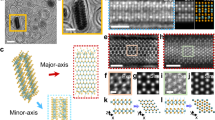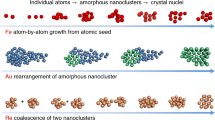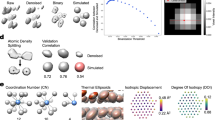Abstract
Although the outer surface of single-walled carbon nanotubes (atomically thin cylinders of carbon) can be involved in a wide range of chemical reactions, it is generally thought that the interior surface of nanotubes is unreactive. In this study, we show that in the presence of catalytically active atoms of rhenium inserted into nanotubes, the nanotube sidewall can be engaged in chemical reactions from the inside. Aberration-corrected high-resolution transmission electron microscopy operated at 80 keV allows visualization of the formation of nanometre-sized hollow protrusions on the nanotube sidewall at the atomic level in real time at ambient temperature. Our direct observations and theoretical modelling demonstrate that the nanoprotrusions are formed in three stages: (i) metal-assisted deformation and rupture of the nanotube sidewall, (ii) the fast formation of a metastable asymmetric nanoprotrusion with an open edge and (iii) a slow symmetrization process that leads to a stable closed nanoprotrusion.
This is a preview of subscription content, access via your institution
Access options
Subscribe to this journal
Receive 12 print issues and online access
$259.00 per year
only $21.58 per issue
Buy this article
- Purchase on Springer Link
- Instant access to full article PDF
Prices may be subject to local taxes which are calculated during checkout



Similar content being viewed by others
References
Tasis, D., Tagmatarchis, N., Bianco, A. & Prato, M. Chemistry of carbon nanotubes. Chem. Rev. 106, 1105–1136 (2006).
Britz, D. A., Khlobystov, A. N., Porfyrakis, K., Ardavan, A. & Briggs, G. A. D. Chemical reactions inside single-walled carbon nano test-tubes. Chem. Commun. 37–39 (2005).
Pagona, G. et al. Azafullerenes encapsulated within single-walled carbon nanotubes. J. Am Chem. Soc. 130, 6062–6063 (2008).
Koshino, M. et al. Analysis of the reactivity and selectivity of fullerene dimerization reactions at the atomic level. Nature Chem. 2, 117–124 (2010).
Bandow, S., Takizawa, M., Hirahara, K., Yudasaka, M. & Iijima, S. Raman scattering study of double-wall carbon nanotubes derived from the chains of fullerenes in single-wall carbon nanotubes. Chem. Phys. Lett. 337, 48–54 (2001).
Warner, J. H. et al. One-dimensional confined motion of single metal atoms inside double-walled carbon nanotubes. Phys. Rev. Lett. 102, 195504 (2009).
Sloan J. et al. Capillarity and silver nanowire formation observed in single-walled carbon nanotubes. Chem. Commun. 699–700 (1999).
Chamberlain, T. W., Gimenez-Lopez, M. C. & Khlobystov A. N. Carbon Nanotubes (eds Guldi, D. M. & Martín, N.) Ch. 12 (Wiley, 2010).
Hernandez, E. et al. Fullerene coalescence in nanopeapods: a path to novel tubular carbon. Nano Lett. 3, 1037–1042 (2003).
Terrones, M. Transmission electron microscopy visualizing fullerene chemistry. Nature Chem. 2, 82–83 (2010).
Egerton, R. F., Li, P. & Malac, M. Radiation damage in the TEM and SEM. Micron 35, 399–409 (2004).
Grubbs, H. R. in Comprehensive Organometallic Chemistry Vol. 8 (eds Wilkinson, G., Stone, F. G. A. & Abel, E. W.) Ch. 54 (Pergamon, 1982).
Toganoh, M., Matsuo, Y. & Nakamura, E. Rhenium-templated regioselective polyhydrogenation reaction of [60]fullerene. Angew. Chem. Int. Ed. 42, 3530–3532 (2003).
Ulbricht, H., Moos, G. & Hertel, T. Interaction of C-60 with carbon nanotubes and graphite. Phys. Rev. Lett. 90, 095501 (2003).
Girifalco, L. A. & Hodak, M. Van der Waals binding energies in graphitic structures. Phys. Rev. B 65, 125404 (2002).
Suenaga, K. et al. Direct imaging of Sc2@C84 molecules encapsulated inside single-wall carbon nanotubes by high resolution electron microscopy with atomic sensitivity. Phys. Rev. Lett. 90, 055506 (2003).
Sato, Y. et al. Direct imaging of intracage structure in titanium–carbide endohedral fullerenes. Phys. Rev. B 73, 193401 (2006).
Jin, C. et al. Metal atom catalysed enlargement of fullerenes. Phys. Rev. Lett. 101, 176102 (2008).
Urita, K. et al. Defect-induced atomic migration in carbon nanopeapod: tracking the single-atom dynamic behavior. Nano Lett. 4, 2451–2454 (2004).
Chuvilin, A. et al. Observations of chemical reactions at the atomic scale: dynamics of metal-mediated fullerene coalescence and nanotube rupture. Angew. Chem. Int. Ed. 49, 193–196 (2010).
Huang, J. Y., Ding, F., Jiao, K. & Yakobson, B. I. Realtime microscopy, kinetics, and mechanism of giant fullerene evaporation. Phys. Rev. Lett. 99, 175503 (2007).
Irle, S., Zheng, G. S., Wang, Z. & Morokuma, K. The C-60 formation puzzle ‘solved’: QM/MD simulations reveal the shrinking hot giant road of the dynamic fullerene self-assembly mechanism. J. Phys. Chem. B 110, 14531–14545 (2006).
Chabanas, M., Baudouin, A., Coperet, C. & Basset, J. M. A highly active well-defined rhenium heterogeneous catalyst for olefin metathesis prepared via surface organometallic chemistry. J. Am. Chem. Soc. 123, 2062–2063 (2001).
Frech, C. M., Blacque, O., & Berke, H. Dinitrosyl rhenium complexes for ring-opening metathesis polymerization (ROMP). Pure Appl. Chem. 78, 1877–1887 (2006).
Weinstock, I. A., Schrock, R. R. & Davis, W. M. Rhenium(VII) monoimido alkylidyne complexes – the importance of face selectivity in the metathesis of acetylenes via rhenacyclobutadiene intermediates. J. Am. Chem. Soc. 113, 135–144 (1991).
Chuvilin, A., Kaiser, U., Bichoutskaia, E., Besley, N. A. & Khlobystov, A. N. Direct transformation of graphene to fullerene. Nature Chem. 2, 450–453 (2010).
Suarez-Martinez, I. et al. Transition metal deposition on graphene and carbon nanotubes. J. Nanosci. Nanotech. 9, 6171–6175 (2009).
Ivanovskaya, V. V., Köhler, C. & Seifert, G. 3d-metal nanowires and clusters inside carbon nanotubes: structural, electronic and magnetic properties. Phys. Rev. B 75, 075410 (2007).
Ewels, C. P., Heggie, M. I. & Briddon, P. R. Adatoms and nanoengineering of carbon. Chem. Phys. Lett. 351, 178–182 (2002).
Nasibulin, A. G. et al. A novel hybrid carbon material. Nature Nanotech. 2, 156–161 (2007).
Zhao, Y. F., Lin, Y. & Yakobson, B. I. Fullerene shape transformations via Stone–Wales bond rotations. Phys. Rev. B 68, 233403 (2003).
Tian, Y. Combined Raman spectroscopy and transmission electron microscopy studies of a NanoBud structure. J. Am. Chem. Soc. 130, 7188–7189 (2008).
Gorantla, S. et al. In situ observation of fullerene fusion and ejection in carbon nanotubes. Nanoscale 2, 2077–2079 (2010).
Nasibulin, A. G. et al. Investigation of NanoBud formation. Chem. Phys. Lett. 446, 109–114 (2007).
He, H. Y. & Pan, B. C. Electronic structures and Raman features of carbon nanobud. J. Phys. Chem. C 113, 20822–20826 (2009).
Shao, Y. et al. Advances in methods and algorithms in a modern quantum chemistry program package. Phys. Chem. Chem. Phys. 8, 3172–3191 (2006).
Brenner, D. W. Empirical potential for hydrocarbons for use in simulating the chemical vapour-deposition of diamond films. Phys. Rev. B 42, 9458–9471 (1990).
Gale, J. D. & Rohl, A. L. The General Utility Lattice Program (GULP). Mol. Simul. 29, 291–341 (2003).
Acknowledgements
This work was supported by the German Research Foundation (DFG) and the Federal State of Baden-Württemberg within the Sub-Ångstrøm Low-Voltage Electron Microscopy project, by the Collaborative Research Centre SFB 569 of the DFG, by the UK Engineering and Physical Research Council (Career Acceleration Fellowship to E.B.), by the High Performance Computing (HPC) facility at the University of Nottingham (E.B., N.A.B. and A.S.) and by the Royal Society and the European Science Foundation (A.N.K.).
Author information
Authors and Affiliations
Contributions
T.W.C. conceived the experiments, synthesized the materials and analysed the microscopy data. J.B., J.C.M. and J.L. recorded the AC-HRTEM images and contributed to the initial explanation of the observations. J.B. analysed the images and carried out TEM image simulations. E.B., N.A.B. and A.S. performed the theoretical modelling and explained the details of the reaction mechanisms. U.K. contributed to the development of the experimental methodology and discussion of the results. A.N.K. conceived the initial idea, proposed the general mechanism and wrote the original manuscript. All authors discussed the results and commented on the manuscript.
Corresponding authors
Ethics declarations
Competing interests
The authors declare no competing financial interests.
Supplementary information
Supplementary information
Supplementary information (PDF 1356 kb)
Supplementary movie 1
Supplementary movie 1 (AVI 3160 kb)
Supplementary movie 2
Supplementary movie 2 (AVI 3017 kb)
Rights and permissions
About this article
Cite this article
Chamberlain, T., Meyer, J., Biskupek, J. et al. Reactions of the inner surface of carbon nanotubes and nanoprotrusion processes imaged at the atomic scale. Nature Chem 3, 732–737 (2011). https://doi.org/10.1038/nchem.1115
Received:
Accepted:
Published:
Issue Date:
DOI: https://doi.org/10.1038/nchem.1115
This article is cited by
-
Comparison of atomic scale dynamics for the middle and late transition metal nanocatalysts
Nature Communications (2018)
-
Combined Effect of CNTs with ZIF-302 into Polysulfone to Fabricate MMMs for Enhanced CO2 Separation from Flue Gases
Arabian Journal for Science and Engineering (2016)
-
Molecular interactions on single-walled carbon nanotubes revealed by high-resolution transmission microscopy
Nature Communications (2015)
-
Direct synthesis of single-walled aminoaluminosilicate nanotubes with enhanced molecular adsorption selectivity
Nature Communications (2014)
-
Controlled Assembly of Sb2S3 Nanoparticles on Silica/Polymer Nanotubes: Insights into the Nature of Hybrid Interfaces
Scientific Reports (2013)



